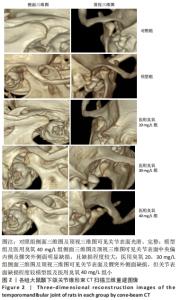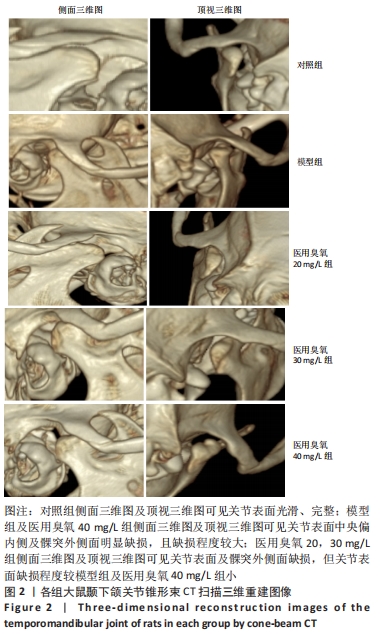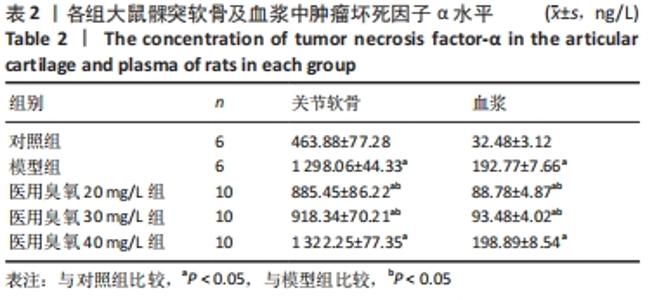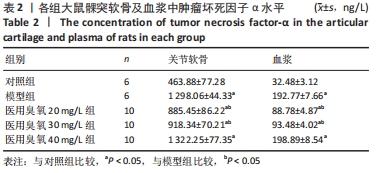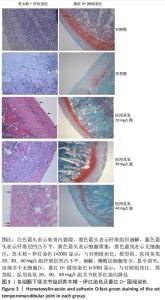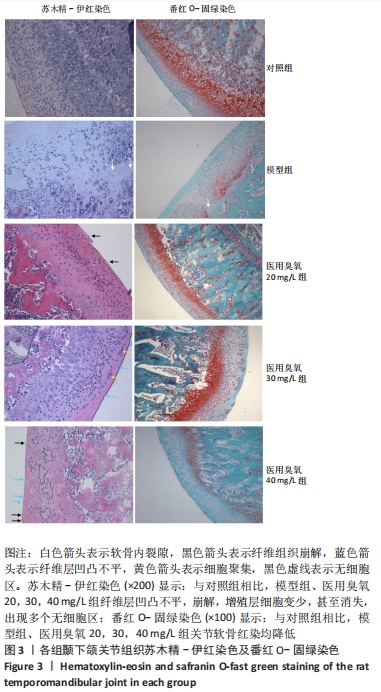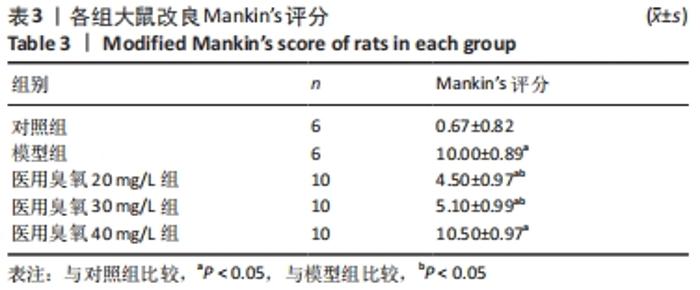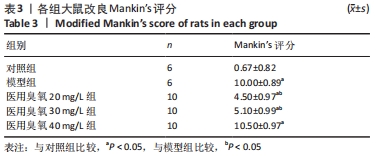[1] WANG XD, ZHANG JN, GAN YH, et al. Current understanding of pathogenesis and treatment of TMJ osteoarthritis. J Dent Res. 2015; 94(5):666-673.
[2] TAMIMI D, JALALI E, HATCHER D. Temporomandibular Joint Imaging. Radiol Clin North Am. 2018;56(1):157-175.
[3] PEREIRA FJ JR, LUNDH H, WESTESSON PL. Morphologic changes in the temporomandibular joint in different age groups. An autopsy investigation. Oral Surg Oral Med Oral Pathol. 1994;78(3):279-287.
[4] MADRY H, LUYTEN FP, FACCHINI A. Biological aspects of early osteoarthritis. Knee Surg Sports Traumatol Arthrosc. 2012;20(3):407-422.
[5] 孙嘉利,范建中,邱玲,等.红外线及磁场对兔膝骨关节炎滑膜损伤的影响[J].中国康复理论与实践,2006,12(10):858-860,921.
[6] TONGE DP, PEARSON MJ, JONES SW. The hallmarks of osteoarthritis and the potential to develop personalised disease-modifying pharmacological therapeutics. Osteoarthritis Cartilage. 2014;22(5): 609-621.
[7] LIU X, MACHADO GC, EYLES JP, et al. Dietary supplements for treating osteoarthritis: a systematic review and meta-analysis. Br J Sports Med. 2018;52(3):167-175.
[8] 王佳玮,张佳君,张飒飒.B超引导下臭氧注射治疗髋关节炎[J].饮食保健,2019,6(17):261.
[9] NOORI-ZADEH A, BAKHTIYARI S, KHOOZ R, et al. Intra-articular ozone therapy efficiently attenuates pain in knee osteoarthritic subjects: A systematic review and meta-analysis. Complement Ther Med. 2019; 42:240-247.
[10] WANG XD, KOU XX, HE DQ, et al. Progression of cartilage degradation, bone resorption and pain in rat temporomandibular joint osteoarthritis induced by injection of iodoacetate. PLoS One. 2012;7(9):e45036.
[11] TIRELLI U, CIRRITO C, PAVANELLO M, et al. Ozone therapy in 65 patients with fibromyalgia: an effective therapy. Eur Rev Med Pharmacol Sci. 2019;23(4):1786-1788.
[12] BOCCI VA. Scientific and medical aspects of ozone therapy. State of the art. Arch Med Res. 2006;37(4):425-435.
[13] 郑昊钰.砭贴预处理对急性低压低氧模型大鼠的自由基和炎性因子的影响[D].北京:北京中医药大学,2020.
[14] LOPES DE JESUS CC, DOS SANTOS FC, DE JESUS LMOB, et al. Comparison between intra-articular ozone and placebo in the treatment of knee osteoarthritis: A randomized, double-blinded, placebo-controlled study. PLoS One. 2017;12(7):e0179185.
[15] 王文譞,庞立健,刘创,等.基于文献分析的慢性疼痛发病机制及治疗现状研究[J].世界科学技术-中医药现代化,2017,19(8):1406-1412.
[16] 黄媛霞,徐海斌,郭春.白细胞介素-1β、肿瘤坏死因子α及基质金属蛋白酶13在骨性关节炎中的表达及相关性[J].广东医学, 2017,38(15):2301-2304.
[17] 薛艳,庞晓林,何军,等.不同疗程医用臭氧关节内注射对兔膝骨关节炎疗效比较[J].中国疼痛医学杂志,2019,25(11):871-875.
[18] 吴昌澄.观察臭氧加玻璃酸钠治疗创伤性踝关节炎的应用效果[J].双足与保健,2019,28(16):161-162.
[19] 周昊,卞菊花,马辉,等.药物注射联合针刀治疗肩周炎临床疗效及安全性分析[J].基因组学与应用生物学,2019,38(5):2432-2436.
[20] CLAVO B, ROBAINA F, URRUTIA G, et al. Ozone therapy versus surgery for lumbar disc herniation: A randomized double-blind controlled trial. Complement Ther Med. 2021;59:102724.
[21] 唐波,任维玲.髋关节腔内注射臭氧及玻璃酸钠治疗股骨头坏死的临床疗效观察[J].中华养生保健,2021,39(4):85-87.
[22] YAMANER FE, CELAKIL T, GÖKCEN ROEHLIG B. Comparison of the efficiency of two alternative therapies for the management of temporomandibular disorders. Cranio. 2020:1-10.
[23] ÖZNUR ÖZALP, NELLI YILDIRIMYAN, ALPER SINDEL, et al. Evaluation of the Short-Term Efficacy of Transdermal Ozone Therapy in Turkish Patients with Internal Derangement of the Temporomandibular Joint. Pesqui Bras Odontopediatria Clin Integr. 2019;19(1):e4442.
[24] 邓力,张清彬,张颖,等.臭氧治疗颞下颌关节炎的临床研究[J].口腔医学研究,2016,32(11):1208-1210.
[25] 杨萍萍,席鹏,王晶,等.关节腔臭氧浴联合物理疗法治疗颞下颌关节不可复性盘前移位的效果评价[J].中国口腔颌面外科杂志, 2021,19(2):121-125.
[26] SILVA JÚNIOR JIS, RAHAL SC, SANTOS IFC, et al. Use of Reticulated Hyaluronic Acid Alone or Associated With Ozone Gas in the Treatment of Osteoarthritis Due to Hip Dysplasia in Dogs. Front Vet Sci. 2020;7: 265.
[27] YILMAZ O, BILGE A, ERKEN HY, et al. The effects of systemic ozone application and hyperbaric oxygen therapy on knee osteoarthritis: an experimental study in rats. Int Orthop. 2021;45(2):489-496.
[28] 刘宁宁,张改连,张莉芸,等.臭氧关节腔注射对胶原诱导性关节炎大鼠干预疗效及血清核因子κB受体活化因子配体护骨因子水平的影响[J].中华风湿病学杂志,2017,21(7):466-470.
[29] 吴志强,周利君,陈嵩,等.椎旁注射臭氧对SD大鼠盘源性疼痛模型的镇痛作用[J].中山大学学报(医学版),2019,40(4):518-524.
[30] RAEISSADAT SA, GHAZI HOSSEINI P, BAHRAMI MH, et al. The comparison effects of intra-articular injection of Platelet Rich Plasma (PRP), Plasma Rich in Growth Factor (PRGF), Hyaluronic Acid (HA), and ozone in knee osteoarthritis; a one year randomized clinical trial. BMC Musculoskelet Disord. 2021;22(1):134.
[31] RAEISSADAT SA, RAYEGANI SM, FOROGH B, et al. Intra-articular ozone or hyaluronic acid injection: Which one is superior in patients with knee osteoarthritis? A 6-month randomized clinical trial. J Pain Res. 2018;11:111-117.
|
